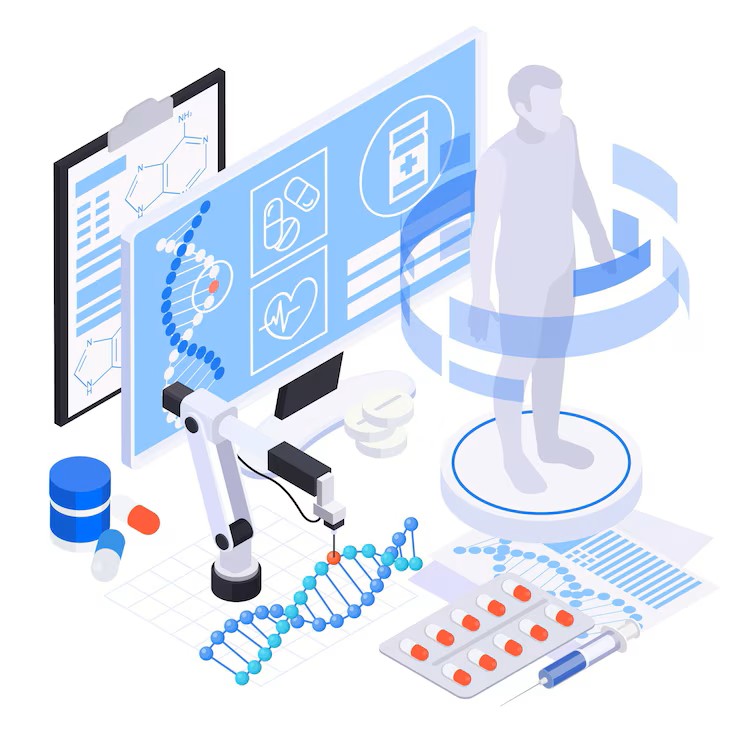
Introduction: Why Predictive Modeling Matters in Precision Medicine
Precision medicine seeks to tailor treatments to individual variability in genetics, environment, and lifestyle—marking a significant shift from the conventional one-size-fits-all approach. At the core of this evolution is predictive modeling, which enables early identification of disease risk, treatment response, and patient outcomes through the analysis of complex, multimodal biomedical data. Artificial intelligence (AI) and machine learning (ML) are accelerating this shift, transforming healthcare into a more proactive, personalized discipline.1
Advanced AI frameworks such as BioGPT and Med-PaLM, combined with algorithms that integrate genomics, clinical data, and imaging, support nuanced patient stratification and dynamic risk assessment. These innovations are central to the emerging paradigm of P4 medicine: predictive, preventive, personalized, and participatory. Although challenges remain—particularly related to data heterogeneity, interoperability, and ethics—the integration of AI into predictive modeling represents a frontier in individualized healthcare, poised to redefine clinical decision-making and improve outcomes across medical domains.2
Foundations: What Is Predictive Modeling in Precision Medicine?
Predictive modeling in precision medicine applies advanced computational methods, particularly supervised ML, to forecast clinical events based on individual patient data. Key tasks include risk prediction, classification, and time-series forecasting, all aimed at anticipating disease onset, progression, or treatment response.
These models synthesize diverse data types—clinical records, genomic profiles, medical imaging, lifestyle factors, and more—capturing the interplay of genetic and environmental influences on health. Common algorithms range from logistic regression and random forests to gradient boosting and deep neural networks, each with distinct strengths in handling heterogeneous biomedical datasets.3
Integration with electronic health records (EHRs), wearable technologies, and multi-omics platforms allows for real-time, continuous data acquisition, improving model performance and enabling dynamic, personalized risk assessments. Despite persistent barriers—such as lack of standardized data and limited model transparency—predictive modeling remains foundational to realizing the full promise of precision medicine.4,5,6
Genomics and Multi-Omics-Based Prediction
AI is revolutionizing the integration and interpretation of genomic and multi-omics data in precision medicine. Algorithms now predict disease risk based on genetic variants, such as BRCA1/2 for breast cancer or APOE for Alzheimer’s disease, facilitating early intervention and risk mitigation.
For complex polygenic traits, ML models enhance polygenic risk scores by refining variable selection and weighting, improving predictive utility. Beyond genomics, the integration of transcriptomics, proteomics, and metabolomics provides a more granular understanding of disease phenotypes.7
AI models have demonstrated success in predicting immunotherapy response using features like tumor mutational burden, immune cell infiltration, and gene expression signatures—enabling precise treatment matching. These capabilities are driven by AI’s ability to manage vast, heterogeneous datasets and to identify clinically relevant molecular patterns, advancing both risk stratification and therapy selection. Despite ongoing challenges in data standardization and validation, AI-powered multi-omics integration is reshaping disease prediction and treatment planning across oncology, neurology, and rare diseases.8,9
Imaging and Radiomics: Data-Rich Precision Forecasting
Radiomics and AI are enhancing precision medicine by extracting and analyzing high-dimensional data from imaging modalities such as CT, MRI, and PET. These models identify subtle patterns beyond human perception, enabling non-invasive predictions of tumor grade, progression, and treatment response.10
Deep learning models analyze radiomic features to infer tumor heterogeneity, immune microenvironment characteristics, and molecular subtypes, contributing to real-time, personalized treatment planning. Integrative approaches that combine imaging with genomic and transcriptomic data have shown promise in forecasting outcomes such as glioblastoma survival and breast cancer recurrence.11,12
For example, AI-based radiogenomic models have achieved high accuracy in linking imaging features with gene expression profiles, offering a new layer of diagnostic and prognostic insight. While data harmonization and interpretability remain concerns, AI-driven radiomics is advancing the integration of molecular biology, imaging, and clinical outcomes, redefining the role of imaging in personalized care.13,14
EHR and Longitudinal Data: Predicting Patient Trajectories
AI applications leveraging EHR and longitudinal patient data are transforming static risk models into dynamic tools capable of forecasting disease trajectories in real time. Time-series analysis enables early detection of acute events such as sepsis, ICU readmission, or cardiac arrest, offering clinicians advanced warning for timely intervention.
ML algorithms can also predict individual responses to therapies, identify patients likely to benefit from specific treatments, and support decisions around care escalation or de-escalation. For example, predictive models have been used to forecast diabetes progression or drug toxicity by analyzing years of EHR and lifestyle data, enhancing both safety and efficacy.15
Deep learning frameworks trained on longitudinal datasets are particularly adept at modeling temporal relationships, capturing fluctuations in patient physiology and informing personalized care plans. As the availability of high-quality longitudinal datasets grows, AI’s ability to transform care from reactive to proactive will continue to expand—offering clinicians unprecedented tools for individualized patient management.
Reference:
Advancing precision medicine: the transformative role of artificial intelligence. Cancer Biol Med.2025; [PMCID: PMC12025054].
Advances in AI and machine learning for predictive medicine. J Hum Genet. 2024; [PMID: 36864440].
Dhumale A. Predictive Analytics in Precision Medicine Leveraging Machine Learning Algorithms. Afr J Biomed Sci. 2024;6(Si2):2413-2423.
Precision Medicine, AI, and the Future of Personalized Health Care. J Pers Med. 2021; [PMC7877825].
Predictive Modeling in Medicine: A Complex Methodology with Untapped Potential. Med Sci.2023;3(2):42.
Clinical prediction models in the precision medicine era. J Clin Epidemiol. 2020; [PMC7186705].
Editorial: Computational genomic and precision medicine. Frontiers in Genetics. 2025.
Advancing precision medicine: the transformative role of artificial intelligence. Cancer Biology & Medicine. 2025.
Alsaedi S, et al. AI-powered precision medicine: utilizing genetic risk factor optimization to revolutionize healthcare. NAR Genomics and Bioinformatics. 2025;7(2):lqaf038
Arimura H, et al. Advancing precision medicine: the transformative role of artificial intelligence in radiomics. Cancer Biol Med. 2025 Jan 6.
Frontiers in Medicine. Revolutionizing precision oncology: the role of artificial intelligence. 2025.
Zhang Y, et al. Radiogenomics signatures predict glioblastoma survival integrating MRI and DNA methylation. Life (Basel). 2024;14(10):1248.
Frontiers in Medicine. Revolutionizing precision oncology: the role of artificial intelligence. 2025.
Luan S, et al. Radiomics predicts immune cell infiltration and prognosis in glioblastoma. Life Sci. 2024.
Johnson KB, Wei WQ, Weeraratne D, Frisse ME, Misulis K, Rhee K, Zhao J, Snowdon JL. Precision Medicine, AI, and the Future of Personalized Health Care. Clin Transl Sci. 2021 Jan;14(1):86-93. doi: 10.1111/cts.12884. Epub 2020 Oct 12. PMID: 32961010; PMCID: PMC7877825.








Post comments